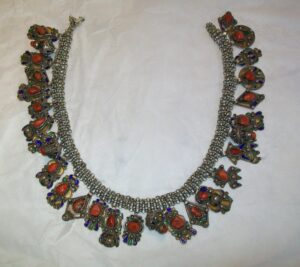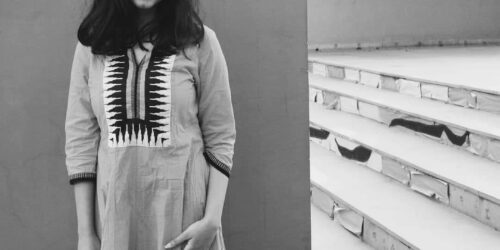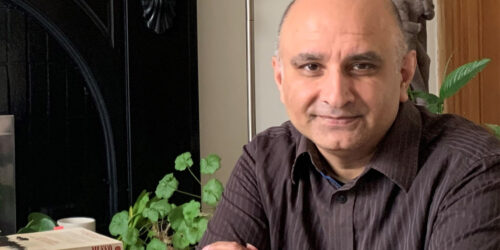
Writer, photographer and translator Lydia Hounat shares her notes while conducting research on the Azrar necklace held at the British Museum.
During a Visible Communities virtual residency, Lydia has been translating the etymologies of different terms used to describe an Azrar necklace held by the British Museum in their digital archive which you can view here. Lydia’s interest is in looking at the limitations of colonial vernacular used in museums and galleries to describe artefacts, often perpetuating erasure and displacing contexts. She has translated the etymological roots of these words, for example the word ‘Berber’, and the limited, violent origins of this term, vs. the more complex and relevant proper name for her community, ‘Imazighen’.
In her residency diary, Lydia explores how colonial language puts an end to conversations about culture and origin, whereas indigenous tongues provide multiplicity and possibilities and deserve recognition and respect. The Visible Communities programme aims to diversify access routes to literary translation, strengthen links between the literary translation community and diaspora communities in the UK and contribute to the debate around decolonising literary translation. You can read more about this programme here, or learn about our residencies here.
Photography credit and copyright of the Azrar necklace belongs to The Trustees of the British Museum.
Read on for an excerpt of Lydia’s notes, and click the link at the end to read the whole piece.
Excerpts from my Notes on the Azrar / Item Af1974,06.1
© The Trustees of the British Museum
1.4.2022 – The Azrar continues on in my work; she follows me. The more I understand it, the faster the blood splurges from each cabochon, each link, each charm. I can’t stop the flow, and yet with every bleed it turns more beautiful. From such a gross misunderstanding of such a piece, emerges a whole sunrise of knowledge.
5.4.2022 – What I’m beginning to understand about museums, worldwide, is that they often perpetuate erasure and misinformation more so than they seek to educate. They preserve these objects in solutions and sprays, in glass boxes, and lock so many of them away; they’re never on display. They bring in archivists without the necessary connections or background knowledge on a particular artefact, to loosely describe this thing that has been donated to the Museum, or found in a historical ransacking of a place, and they misrepresent it. In fact, this word, ‘artefact’, or ‘object’, I take issue with. They create this distance that seems to shed responsibility and our connection to these histories — it’s so clinical! As if they are only defined by their past. But, and I ask myself this question all the time, how can history be a study of the past when the past is so inherently present? These ‘artefacts’ are still being made; precious odes to a revered philosophy within an indigenous community. We shy away from that truth because, we know if we were to really acknowledge the value of something belonging to another, we might have to sit with that terrible shame.
How can history be a study of the past when the past is so inherently present?
Museums, for the most part, are presently institutions of corrosion, not preservation. They are the ongoing rape of a land, of a people. If colonialism is the action happening, museums are the photograph; they are the moment of this violation immortalised in bricks, mortar and ticket sales. It’s particularly pervasive in parts of the world that are the benefactors of Empire, the places that have the world-renowned museums, the big ones, the ones tourists frequent in great swathes. What’s interesting about museums is not only how they write about artefacts and what qualifies as ‘necessary information’ in order to keep the artefact, it’s the languages they choose to write about these artefacts in. I would call this problematic, but that’s putting it too nicely. Really, it’s an extension of the violation indigenous communities have sustained. Because when you look at any entry within the museum’s catalogue, a huge proportion of context and understanding around an artefact and its purpose within an indigenous community is missing, by a failure to actually retain the indigenous vernacular.
6.4.2022 – In many ways, I regret not paying more attention to my Kabyle Nana and the jewellery she wore at weddings. Did she possess Azrar of her own? When and how did she acquire them? What charms did she identify with? Must ask my Aunt Taous.
9.4.2022 – What I know thus far: Item Af1974,06.1 held by the British Museum is categorised as ‘necklace’. This particular necklace is actually known as Azrar, and it originates from Tizi Ouzou, Kabylia, made by the Kabyle people of northeast Algeria. Now, all necklaces can be referred to as Azrar in Taqbaylit, which is a dialect of the Tamazight languages spoken by the indigenous Imazighen. Taqbaylit, spoken by the Kabyle people in northeast Algeria, is an entirely oral language — it has no written form. But it’s only once you’ve seen the necklace can you accurately translate the ‘type’ of Azrar you’re looking at. For example, if you were to travel further into southern Algeria, you might encounter Azrar from the Chaoui community, where they fashion necklaces out of fragrant stones such as lavender. In this case, Azrar would be translated to ‘sweet-smelling necklace’. You see the necklace, you note what it looks like, and the language wraps itself around your observation. I wouldn’t have made this connection if it weren’t for my Dad’s description of how Tamazight languages work; he never expressly said that Taqbaylit embodies this philosophy, but he did say something along the lines of: ‘to feel the world we have to truly look’. This is from a man who undermines his own knowledge of Taqbaylit as a language. He is like the majority who grew up in Algiers; a speaker of Darja. Darja is a melting pot of languages; a dialect of Arabic, some ‘classic’ Arabic (the kind you hear spoken in Syria), French, a little English, and Taqbaylit (if you’re Kabyle of course, otherwise you might incorporate a different Tamazight tongue). But at home, he only ever spoke Taqbaylit as Nana could not speak French (whether it was down to a lack of education or resistance, I’ve never been able to clarify). When I’ve later asked him again, ‘is it true that language has to follow form in this way?’, he seems to hide a bit and says, ‘I think so, yes’. I think the physical distance of being in Britain for so long has alienated Dad from Algeria. He seems to distrust his own translations — his own roots.
When you look at any entry within the museum’s catalogue, a huge proportion of context and understanding around an artefact and its purpose within an indigenous community is missing
16.4.2022 – I forget sometimes that it wasn’t my family that told me that this piece is called Azrar. This knowledge actually came through a conversation I had with Sigrid Van Roode, Jewellery Historian based in the Netherlands last year (16.2.2021). I connected with her at the start of the Writing the Archive programme that Fahad Al-Amoudi invited me to join at the Writing Squad. We had to find an object connected to our heritage, held by the British Museum, and then from that generate poetry or writing from it. So, I found Azrar, aka ‘Item Af1974,06.1’, in the museum’s digital catalogue and fell in love. This is back when the British Museum were still potentially a partner we were going to work with when considering what ‘writing the archive’ was. We were all pretty devastated by how these pieces of our heritage are stored and misunderstood; we all had our questions. When I began researching it, I came across Sigrid’s website and knew she would have some knowledge. She shares in my philosophy about the damage of museums; she even says:
‘But that is to me one of the sides of a museum: pieces are still here because of them. Buttt……. they are separated from their life. They lose their voice. They are reduced to one-sided objects of adornments. […] I work to remedy this character-loss through my books and this account [her Instagram] and classes’.
And this is the thing; initially it was neither my family, nor the Museum that could offer clarity on the Azrar in question. To begin with, it was Sigrid. I wrestle with this a lot — she clarified so much to me, more than my family could. It’s not a bad thing; I love Sigrid. She has such respect and reverence for all jewellery, and is so knowledgeable on such a rich panoply of cultures and their own jewellery designs in the world. But it’s us, we who are not living within the Kabyle world, who have access to an understanding that people like my family have forgotten or simply don’t know. Erasure of self-identity it seems, sometimes, incurable, after sustaining the destruction colonialism inflicts. Forgetting stories, forgetting names, the disappearing truth around the heirlooms worn at weddings is a chronic, intergenerational disease.
Read the full piece →

Lydia Hounat is a British-Algerian (Kabyle) writer, photographer and translator from Manchester, England. She was previously a Writer-in-Residence for Manchester Metropolitan University’s Special Collections’ Archives, and her work has appeared in HOBART, MAI Journal: Feminism & Visual Culture, and TOLKA. She is a co-curator for the French and Imazighen poetry collections at Manchester Poetry Library and is currently collaborating with the Writing Squad’s Writing the Archive project and Poetry Translation Centre’s UNDERTOW. Image (c) Alan Eric Carter
We would like to thank Arts Council England for supporting the Visible Communities programme, the British Centre for Literary Translation for collaboration on the BCLT Summer School, the Stephen Spender Trust for Multilingual Creators, the Francis W Reckitt Arts Trust for supporting residencies at Dragon Hall, and the Jan Michalski Foundation for their support for the Tilted Axis Press anthology and our virtual residencies.


You may also like...
Decolonising translation: a report by Coco Mbassi
A Visible Communities commission by our virtual resident Coco Mbassi

21st December 2022
Translating Tagore in Norwich
‘The timekeepers of this city have perhaps witnessed a passer-by cosplaying as a poet before.’

15th June 2022
Emerging Translator Mentorships: Ten Years On
Vineet Lal reflects on his career over the past decade and shares his advice for emerging translators

31st March 2021







